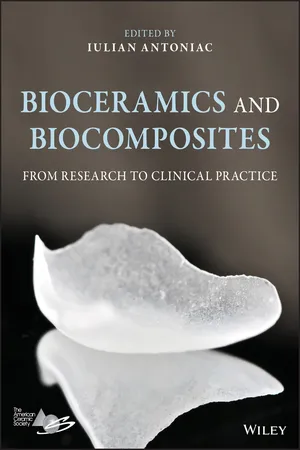
Bioceramics and Biocomposites
From Research to Clinical Practice
Iulian Antoniac, Iulian Antoniac
- English
- ePUB (mobile friendly)
- Available on iOS & Android
Bioceramics and Biocomposites
From Research to Clinical Practice
Iulian Antoniac, Iulian Antoniac
About This Book
Provides comprehensive coverage of the research into and clinical uses of bioceramics and biocomposites
Developments related to bioceramics and biocomposites appear to be one the most dynamic areas in the field of biomaterials, with multiple applications in tissue engineering and medical devices. This book covers the basic science and engineering of bioceramics and biocomposites for applications in dentistry and orthopedics, as well as the state-of-the-art aspects of biofabrication techniques, tissue engineering, remodeling, and regeneration of bone tissue. It also provides insight into the use of bionanomaterials to create new functionalities when interfaced with biological molecules or structures.
Featuring contributions from leading experts in the field, Bioceramics and Biocomposites: From Research to Use in Clinical Practice offers complete coverage of everything from extending the concept of hemopoietic and stromal niches, to the evolution of bioceramic-based scaffolds. It looks at perspectives on and trends in bioceramics in endodontics, and discusses the influence of newer biomaterials use on the structuring of the clinician's attitude in dental practice or in orthopedic surgery. The book also covers such topics as biofabrication techniques for bioceramics and biocomposites; glass ceramics: calcium phosphate coatings; brain drug delivery bone substitutes; and much more.
- Presents the biggest trends in bioceramics and biocomposites relating to medical devices and tissue engineering products
- Systematically presents new information about bioceramics and biocomposites, developing diagnostics and improving treatments and their influence on the clinicians' approaches
- Describes how to use these biomaterials to create new functionalities when interfaced with biological molecules or structures
- Offers a range of applications in clinical practice, including bone tissue engineering, remodeling, and regeneration
- Delineates essential requirements for resorbable bioceramics
- Discusses clinical results obtained in dental and orthopedic applications
Bioceramics and Biocomposites: From Research to Use in Clinical Practice is an excellent resource for biomaterials scientists and engineers, bioengineers, materials scientists, and engineers. It will also benefit mechanical engineers and biochemists who work with biomaterials scientists.
Frequently asked questions
Information
1
Multifunctionalized Ferri‐liposomes for Hyperthermia Induced Glioma Targeting and Brain Drug Delivery
1.1 Introduction
1.1.1 Blood–brain Barrier
1.1.1.1 What is the Blood–brain Barrier (BBB)?
| Pathways | Paracellular or transcellular | Molecules being transported | Available for drug delivery |
| Hydrophilic pathway | Paracellular | Water‐soluble small molecules (water, ethanol) | No |
| Lipophilic pathway | Transcellular | Lipid‐soluble small molecules (caffeine) | Yes |
| Transport proteins | Transcellular | Glucose, amino acids, vitamins, fatty acids | Yes |
| Receptor‐mediated transcytosis | Transcellular | Insulin, tranferin | Yes |
| Adsorptive‐mediated transcytosis | Transcellular | Plasma proteins (albumin) | Yes |

1.1.1.2 The BBB Formation and Composition

1.1.1.3 Endothelial Cell and Tight Junctions
Table of contents
- Cover
- Table of Contents
- List of Contributors
- 1 Multifunctionalized Ferri‐liposomes for Hyperthermia Induced Glioma Targeting and Brain Drug Delivery
- 2 Biofabrication Techniques for Ceramics and Composite Bone Scaffolds
- 3 Developments in Hydrogel‐based Scaffolds and Bioceramics for Bone Regeneration
- 4 Zirconia‐Based Composites for Biomedical Applications
- 5 Bioceramics Derived from Marble and Sea Shells as Potential Bone Substitution Materials
- 6 Bioglasses and Glass‐Ceramics in the Na2O–CaO–MgO–SiO2–P2O5–CaF2 System
- 7 Electrical Functionalization and Fabrication of Nanostructured Hydroxyapatite Coatings
- 8 Bioactive Micro‐arc Calcium Phosphate Coatings on Nanostructured and Ultrafine‐Grained Bioinert Metals and Alloys
- 9 Engineering of Bioceramics‐Based Scaffold and Its Clinical Applications in Dentistry
- 10 Bioceramics in Endodontics
- 11 Extending the Concept of Hemopoietic and Stromal Niches as an Approach to Regenerative Medicine
- 12 Experimental and Pilot Clinical Study of Different Tissue‐Engineered Bone Grafts Based on Calcium Phosphate, Mesenchymal Stem Cells, and Adipose‐Derived Stromal Vascular Fraction
- 13 Bone Substitutes in Orthopedic and Trauma Surgery
- Index
- End User License Agreement